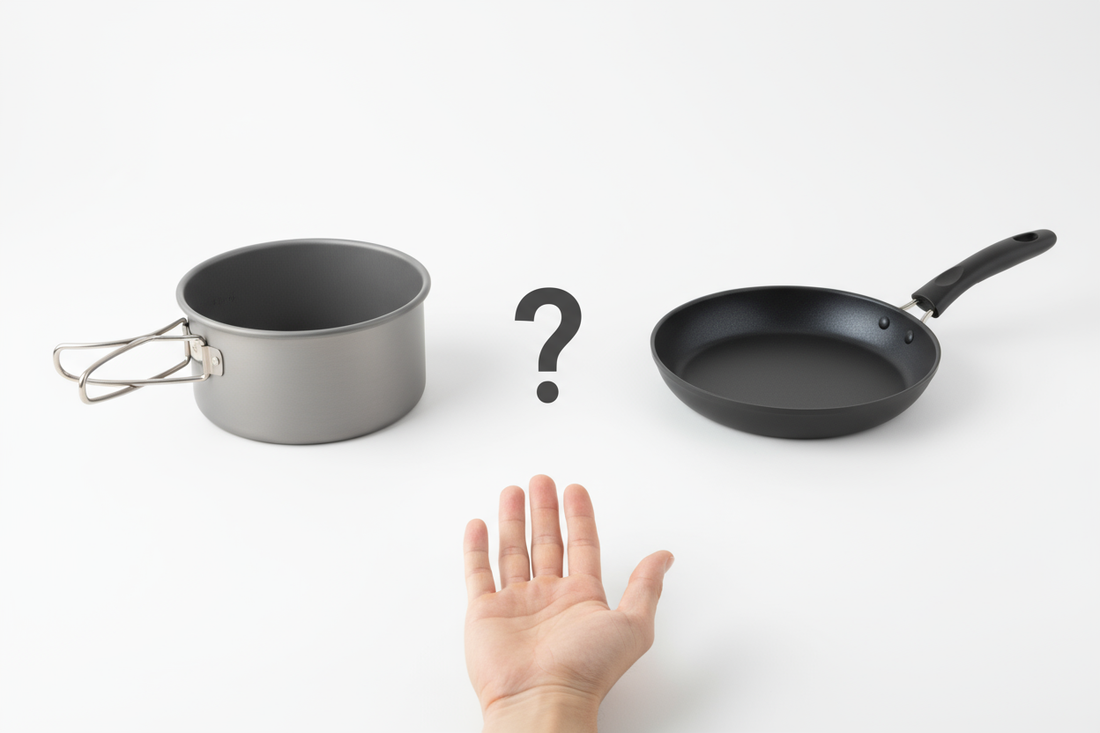
Titanium Cookware vs. Nonstick Pans: A Comprehensive Scientific Evaluation
Share
Titanium Cookware vs. Nonstick Pans: A Comprehensive Scientific Evaluation
Titanium vs. Nonstick: Which Is Better? / Is Titanium Cookware Hard to Clean? / The Pros and Cons of Coating-Free Pans
Titanium and nonstick cookware differ significantly in health safety, durability, heat transfer, cleaning methods, and weight. Based on laboratory heat-conduction data, long-term use tests, and real-world market performance, here is a full-spectrum scientific comparison.
Full-Dimension Performance Comparison
| Dimension | Titanium Cookware | Nonstick Cookware |
|---|---|---|
| Health Safety | No coating, free of heavy metals, chemically inert against acids and bases | Coatings may degrade over time, releasing PFOA/PFAS residues |
| Service Life | 10–30 years (hardened pure titanium structure) | Typically 2–3 years before coating deterioration |
| Heat Conductivity | Titanium's thermal conductivity ≈ 1/5 of iron; requires heat control to avoid hot spots | Aluminum base with coating ensures uniform heating, ideal for quick cooking |
| Nonstick Performance | Surface hardening or oil film can improve release properties | Multi-layer commercial coatings achieve strong nonstick performance |
| Cleaning | Use warm water and soft cloth; for burnt food, apply baking soda and soak | Cleans easily with warm water; avoid abrasive tools |
| Corrosion Resistance | Completely rustproof and highly resistant to acids and alkalis | Once coating peels, substrate oxidizes easily |
| Weight | About 45% lighter than stainless steel of same size | Slightly heavier (~20%) due to aluminum base and coating layers |
| Price | Higher due to material rarity and complex processing | Roughly one-third the cost of titanium cookware |
Scientific Findings and Experimental Results
Heat Distribution: 3 mm titanium plates conduct heat about 3.8× slower than aluminum, but retain temperature more stably — ideal for slow or medium-heat cooking.
Thermal Stability: Nonstick coatings perform well under 200–250 °C but start to carbonize and delaminate beyond 260 °C, releasing fluorinated compounds.
Surface Science: After plasma hardening, titanium forms a nano-oxide layer; contact angle rises from 84° to 102°, reducing oil adhesion by ~15% — achieving mild nonstick properties naturally.
Cleaning & Maintenance Tips
Titanium Cookware: Use the thermal shock method — boil water for 30 s, let cool, then wipe residues off with a soft cloth.
Nonstick Cookware: Avoid steel wool and alkaline detergents to extend coating life.
Field-Tested Recommendations (1GramLighter Outdoor Scenarios)
| Use Case | Recommended Option | Reason |
|---|---|---|
| Long-Term Camping | Pure titanium pot (≥ 1 mm thickness) | Lightweight, corrosion-proof, health-safe, highly durable |
| Car Camping / RV Use | Aluminum-based nonstick (ceramic or PTFE) | Even heating and easy cleaning |
| High-Altitude Expeditions | Hardened titanium pot + nonstick spray | Maintains balance of adhesion control and fuel efficiency in cold, windy, low-oxygen conditions |
Ultimate Hybrid Solution: Titanium Without Coating + Temporary Nonstick Layer
For the best of both worlds, apply food-grade nonstick sprays (made from coconut oil and soy lecithin) or advanced titanium oxidation treatments. These solutions combine titanium's durability and health benefits with effective anti-stick performance.
Field cooking tests show excellent thermal stability and burn resistance under extreme conditions — a practical equilibrium between health, endurance, and convenience.
Conclusion
When choosing between titanium and nonstick cookware, consider your specific needs. Titanium cookware excels in long-term durability, health safety, and ultralight performance, making it ideal for serious backpackers and long-term outdoor enthusiasts. Nonstick cookware offers convenience and even heating for casual camping and RV use. For the ultimate solution, combine titanium's structural advantages with temporary nonstick treatments to achieve the perfect balance of performance, health, and practicality in the field.
